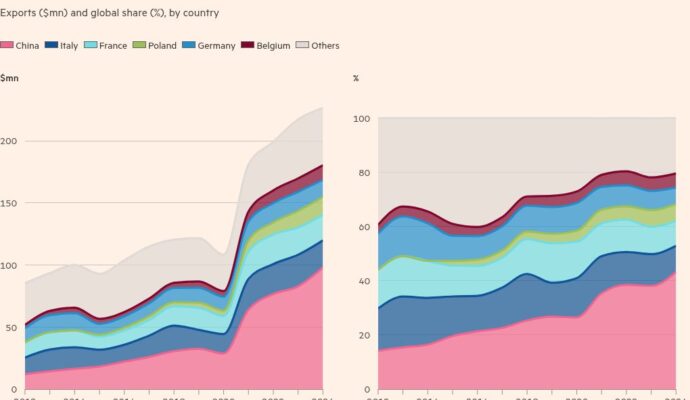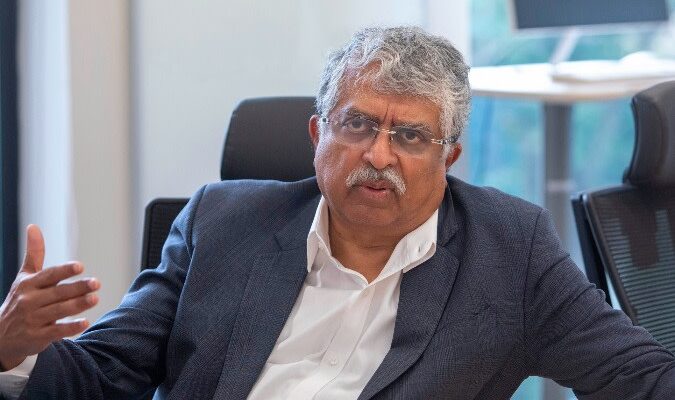Good morning. This has been a strange week, news-wise. Much like the rains in Delhi there seems to be a lot brewing beyond the horizon, and some storms impending, but very little to show for it at the moment. Quarterly GDP numbers will be out later today. Send me your predictions before the announcement.
In today’s newsletter: India is trying to protect agricultural products and dairy from US imports. But first, can Bhavish Aggarwal save Ola Electric?
Ola’s scooters skid
Ola Electric, the two-wheeler EV manufacturer that was once a kind of poster child for young India’s entrepreneurial promise, continues its downward slide. Legacy scooter manufacturers TVS Motor and Bajaj Auto now sell more electric two-wheelers. Ola, which commanded nearly half the market in May last year, can now claim only 20 per cent. Its results for the latest quarter announced on Thursday showed revenues slid 62 per cent year on year and losses mounted to Rs8.7bn.
The company, which went public in August 2024, is plagued with problems. The IPO raised Rs60bn ($700mn) for growth and expansion, but that does not seem sufficient. Earlier this month, the board approved raising a further Rs15bn through debt instruments such as non-convertible debentures in order to support business operations. Since its debut, the stock has lost 30 per cent, closing at Rs53 on Thursday, before the company announced its results.
Ola Electric is facing a slew of challenges. The stock market regulator is investigating allegations its sales figures were overinflated and do not match the government’s vehicle registration data. The regulator has also cautioned the company for its tendency to release material information on social media before informing investors, a violation of disclosure requirements. The ministry of heavy industries is also investigating Ola’s sales data, since the company benefits from the government’s production-linked incentive scheme. And earlier this year, the transport department in four states issued notices to the company for operating showrooms without proper paperwork.
Through all this, Ola’s founder and chief executive Bhavish Aggarwal, who I think seems to fancy himself as a homegrown Elon Musk, has continued his social media offensive, firing salvos at stand-up comedian Kunal Kamra and others who complained about the company’s aftersales service. This has not helped his case, or endeared potential customers to his products.
Aggarwal likes being the brash start-up wunderkind. This is a shtick that works when you are successful. In the current market environment, investor and customer patience is wearing thin. What the company needs now is a leader who puts his head down and focuses on solving some fundamental product and marketing problems. Unless Aggarwal comes up with a brilliant turnaround strategy, Ola Electric will not be zooming anywhere. I am not holding my breath.
Do you think Bhavish Aggarwal will be able to turn Ola Electric around? Hit reply or email me at indiabrief@ft.com
Recommended stories
What can we learn from China’s dominance in manufacturing?
McKinsey sheds 10 per cent staff in a two-year profitability drive.
Jamshyd Godrej has big plans for Mumbai.
French business schools are fast-tracking applications for foreign students facing blocs in the US.
India’s Instagram prince wants to make his dynasty fit for the 21st century.
Want to quit your smartphone addiction? There’s an app for that.
Farm to table
Protecting agriculture and dairy is India’s top priority in trade negotiations with the US, and to this end it is willing to take deep cuts in import tariffs on a wide range of American goods.
India ranked second globally in agriculture production value in 2023, and though the sector’s share in the economy has fallen in the past 25 years, at 16 per cent, it still contributes a larger share than in other major countries. It also employs 44 per cent of the country’s population. While India will allow cheaper imports of some less sensitive farm products such as almonds, currently subject to import duties of up to 120 per cent, it will maintain a higher barrier on foodgrains and milk products.
India has been racing to complete the first round of negotiations before July 9, when Trump’s reciprocal taxes of 26 per cent were expected to kick in — although with the legal tussle now over Trump’s tariffs, who knows what will happen. Nevertheless, the Modi government’s preference will be to get the deal done quickly in order to avoid the continued uncertainty fuelled by Trump’s frequent threats and U-turns. (TACO — Trump Always Chickens Out — as my colleague Robert Armstrong puts it.)
India’s economic policy is leaning heavily on the deal. In its monthly report for April published this week, the finance ministry noted that a successful deal with the US “could transform current headwinds into tailwinds”, opening up new markets and energising exports. This is overly optimistic, in my view. While agriculture is getting some protection, manufacturing is adrift. Some sectors, most notably electronics and semiconductors, are increasing capacity as part of the “China plus one” strategy, but others are more reluctant to spend more on capital expenditure without any certainty on what the future will hold.
One analyst told me that as there is no clarity on what even the next six to 12 months will look like, exporters in sectors such as textiles and fabrics were choosing to wait and watch rather than commit money now. Exporters are also concerned that China will find a way to be more cost effective than India despite higher tariffs. In a worrying sign, industrial output growth slipped to an eight-month low in April, according to data released on Thursday.
Go figure
Kush Maini has become the first Indian driver ever to win a Formula 2 race. Here’s a snapshot.
1
Monaco F2 place
2023
F2 debut
Read, hear, watch
I started watching Sirens, because Netflix was throwing it at me no matter which corner of the internet I was in, claiming I’d love it. Reader, what in the world is going on in that show? Is it a satire about rich people? Is it a show about a difficult sibling relationship? Or was it simply made to fill us with real estate envy? I have no idea. I gave up after three episodes. If you have any shows you think I’ll enjoy, please send them my way.
Buzzer round
What connects Spazl, Ptitim, Paccheri and Testaroli?
Send your answer to indiabrief@ft.com and check Tuesday’s newsletter to see if you were the first one to get it right.
Quick answer
On Tuesday, we asked: Do you think Trump will further postpone his “liberation day” tariffs? And the result is . . . we don’t know. The poll has gone missing. Apologies!

Thank you for reading. Today’s India Business Briefing is edited by Mure Dickie. Please send feedback, suggestions (and gossip) to indiabrief@ft.com.



